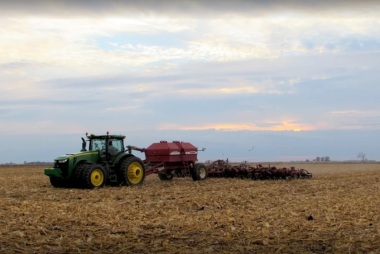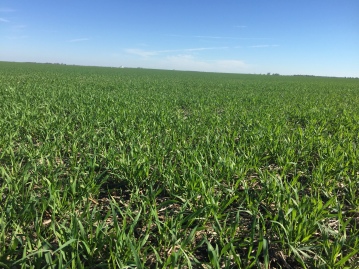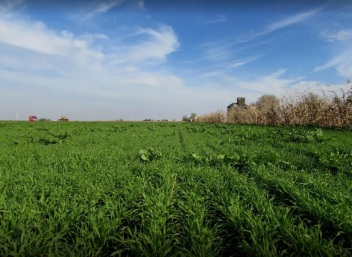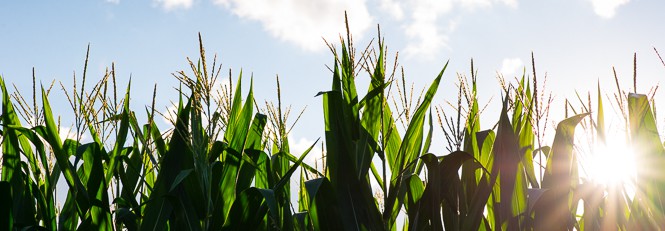Cover Crop is a broad term meaning a plant that is grown in the “off season” of cash crops used to protect and enrich the soil. Cover crops are typically either a grass type crop such as rye, oats, or wheat or a legume which fixates nitrogen such as hairy vetch, winter peas, or crimson clover.

While it seems everybody in agriculture has a different mixture and ratio of cover crops, overall all agriculture personnel and cover crops are aimed at the same goal. The grass family of cover crops is typically cheaper to plant and easier to obtain. It is likely that your local agriculture retailer keeps these products on hand in the late summer and fall. These products are easy to plant and will grow quickly, allowing a large window of planting dates. Typically it can be seen that the plants will grow the largest the earlier they are planted. It is recommended to seed most cover crops at least 30 days before the first expected heavy frost.
Grass cover crops do the best job of preventing erosion of soil. They hold the soil together
with their roots and any soil that does get lost is slowed down and caught in the blades of grass, while other cover crops like radishes and turnips penetrate the soil and act as natural aeration and reduce compaction. Many people are also attracted to use some sort of legume cover crop, because they will fixate nitrogen and reduce the amount of

nutrients and by using the left over nutrients from corn or soybeans, it prevents products such as nitrogen and phosphorous from leaching or washing into creeks and rivers. Then, in the spring when the cover crop is killed from either the cold winter or from chemicals, the nutrients are re-released into the soil as the plant decomposes.
Between preventing erosion and holding nutrients, cover crops can be the most important tool farmers use to protect our creeks and rivers. I think that it is important that more farmers become proactive with protecting the soil, rivers, and other water supplies due to recent growing concerns over how farming will be regulated. There would be no need for regulation of tillage, fertilizer application, or chemical spraying if more farmers would be proactive about protecting the so il, rivers, and other water supplies. This would lead to less fertilizers in our rivers and eventually lessen or eliminate the impact algae blooms have on the gulf region.
il, rivers, and other water supplies. This would lead to less fertilizers in our rivers and eventually lessen or eliminate the impact algae blooms have on the gulf region.

Another benefit of cover crops is that they reduce pollution by pulling carbon pollution out of the air. A study by Natural Resources Defense Council, a non-profit organization whose goal is to protect natural resources, shows that if half of the corn and soybean acres in the top 10 agriculture states where planted to cover crops it would be the equivalent of taking four million cars off the road.

Cover crops can enrich the soil, add organic matter, improve soil structure, and reduce compaction. They are also relatively cheap to plant, easy to grow, and require almost no additional care besides being planted in the fall and sprayed in the spring. Cover crops also prevent soil erosion, hold nutrients to prevent leaching and runoff, and reduce pollution. Cover crops are really a no brainer when looking at the multiple benefits they provide to farmers and their soil and as well as the benefits that are provided to society.
My name is Layten Peterson, a senior at Western Illinois University. I am majoring in Agriculture Business w ith a minor in Agronomy. I grew up on a small row crop farm just outside of Blandinsville, IL. I went to Southeastern Community College in West Burlington, IA for two years before transferring to WIU. I plan to pursue a career in agriculture retail and sales after graduation.
ith a minor in Agronomy. I grew up on a small row crop farm just outside of Blandinsville, IL. I went to Southeastern Community College in West Burlington, IA for two years before transferring to WIU. I plan to pursue a career in agriculture retail and sales after graduation.


Great post regarding cover crops! It was a very interesting read when it came to the different grass cover crops that one person could use on their farm. Do you use any cover crops on your family’s farm?
LikeLike
Yes, we plant about half of our acres to cover crops. Typically cereal rye or oats with radishes. We also do a couple thousand acres of custom cover crop seeding using a broadcast air seeder in front of a Salford vertical tillage implement (First picture in the blog).
LikeLike
Interesting post Layten! Cover crops are something that is currently starting to become very popular back home and your post answered many questions I had as to why they are becoming so popular.
LikeLike
Good read Layten! Cover crops have definitely changed dramatically over the last few years!
LikeLike
Great article, Layten! I would have to agree that cover crops is a great idea. I did not know the grass family is the best to help prevent erosion. I wish more farmers that have problems with erosion would use cover crops to help.
LikeLike
Very interesting and informative. The benefits of cover crops seem to keep coming out of the wood work and it is cool hearing success stories about cover crops.
LikeLike
I agree with cover crop applications, they have many positive attributes to an agricultural program. The problem is when to exactly apply the cover crops for a good emergence. Once problem is solved i believe farmers will apply more cover crops to more acres to improve soil biology. Hopefully in the future they will benefit farmers and the environment.
LikeLike